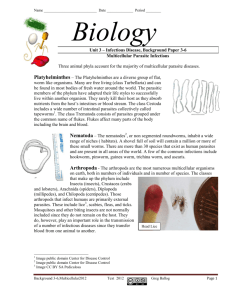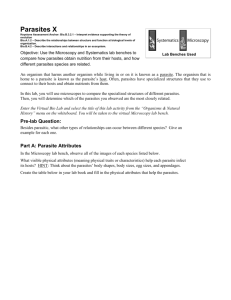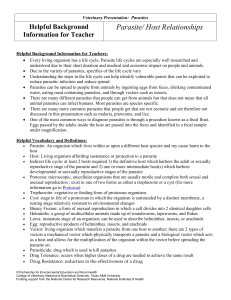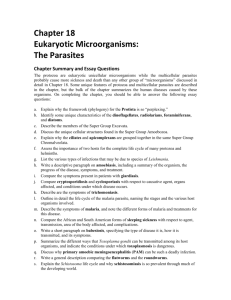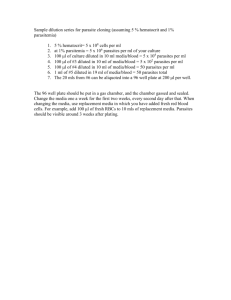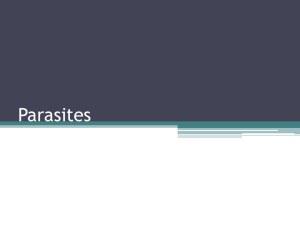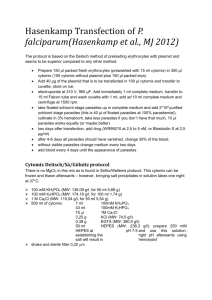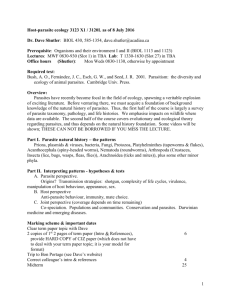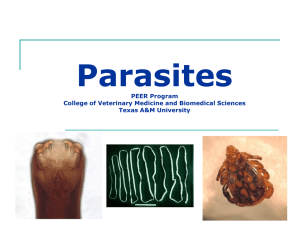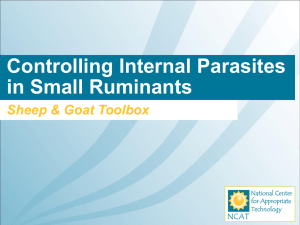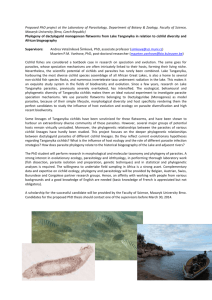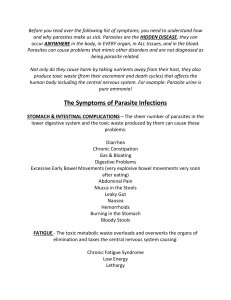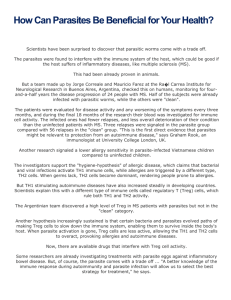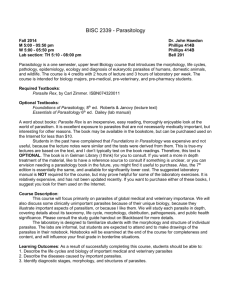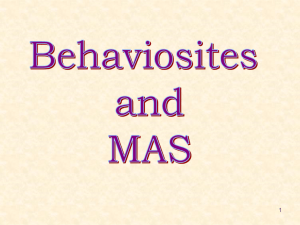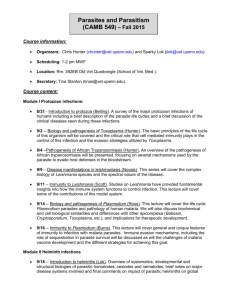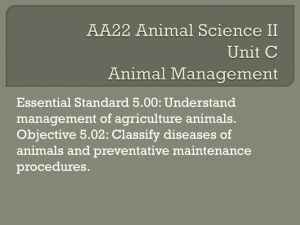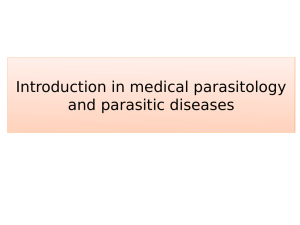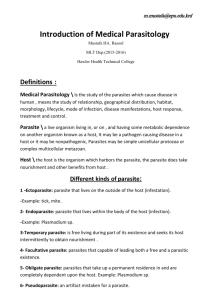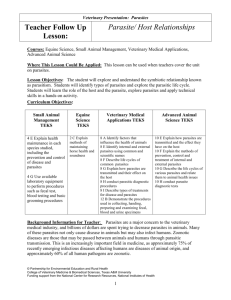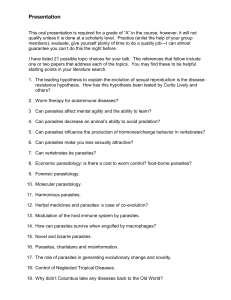Lecture 18
advertisement
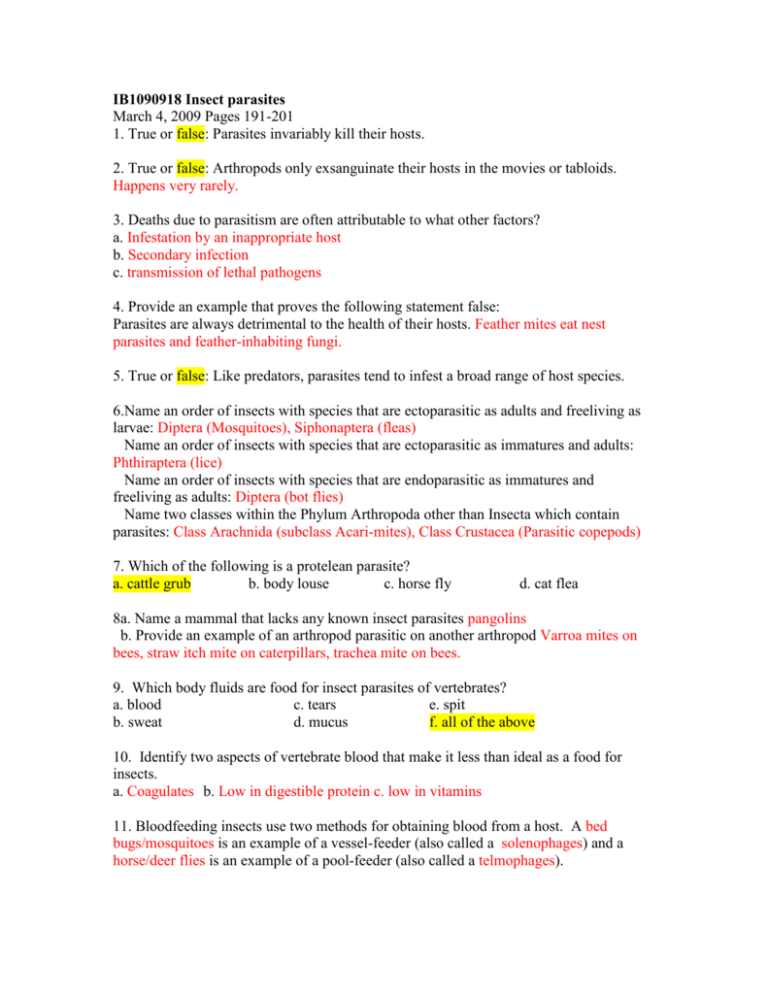
IB1090918 Insect parasites March 4, 2009 Pages 191-201 1. True or false: Parasites invariably kill their hosts. 2. True or false: Arthropods only exsanguinate their hosts in the movies or tabloids. Happens very rarely. 3. Deaths due to parasitism are often attributable to what other factors? a. Infestation by an inappropriate host b. Secondary infection c. transmission of lethal pathogens 4. Provide an example that proves the following statement false: Parasites are always detrimental to the health of their hosts. Feather mites eat nest parasites and feather-inhabiting fungi. 5. True or false: Like predators, parasites tend to infest a broad range of host species. 6.Name an order of insects with species that are ectoparasitic as adults and freeliving as larvae: Diptera (Mosquitoes), Siphonaptera (fleas) Name an order of insects with species that are ectoparasitic as immatures and adults: Phthiraptera (lice) Name an order of insects with species that are endoparasitic as immatures and freeliving as adults: Diptera (bot flies) Name two classes within the Phylum Arthropoda other than Insecta which contain parasites: Class Arachnida (subclass Acari-mites), Class Crustacea (Parasitic copepods) 7. Which of the following is a protelean parasite? a. cattle grub b. body louse c. horse fly d. cat flea 8a. Name a mammal that lacks any known insect parasites pangolins b. Provide an example of an arthropod parasitic on another arthropod Varroa mites on bees, straw itch mite on caterpillars, trachea mite on bees. 9. Which body fluids are food for insect parasites of vertebrates? a. blood c. tears e. spit b. sweat d. mucus f. all of the above 10. Identify two aspects of vertebrate blood that make it less than ideal as a food for insects. a. Coagulates b. Low in digestible protein c. low in vitamins 11. Bloodfeeding insects use two methods for obtaining blood from a host. A bed bugs/mosquitoes is an example of a vessel-feeder (also called a solenophages) and a horse/deer flies is an example of a pool-feeder (also called a telmophages). 12. True or false: Mycetomes (mutualistic microorganisms) are most often found in species that are parasitic in all stages of life. 13. The first aphid genome to be sequenced (2010) was a. Aphis fabae b. Acrythosiphon pisum c. Myzus persicae d. Aphis nerii 14. Provide an example that proves the following statement false: Mycetomes are found only in blood-feeding species. Aphids are phloem feeders and have mycetomes. 15. Match the body fluid with the parasite that consumes it a. blood 4 1. certain Malaysian moths b. mucus 2 2. face flies c. spit 3 3. beelouse d. tears 1 4. stable fly 16. One of the adaptations for life as an ectoparasite includes backwards-pointing spines at strategic locations on the body. What are they called and how do they work? Ctenidia facilitate attachment to the host. 17. Which of the following is NOT characteristic of ectoparasitic insects? a. aposematic coloration c. flattening of body b. thick cuticle d. reduced sensory appendages 18. Provide an example of an arthropod involved in dermatosis (infestation of the skin) scabies, itch mite myiasis cattle grub, bot fly canthariasis dung beetles that directly infest digestive tract 19. Where would you expect to find the human parasite Demodex folliculorum? In pores/hair follicles on facial skin Where would you expect to find the human parasite Dermatobia hominis? Under the skin 20. What is phoresy? Attachment to host for transportation only. 21. What component of breath is attractive to a wide range of parasites? a. oxygen b. carbon dioxide c. water vapor d. menthol
